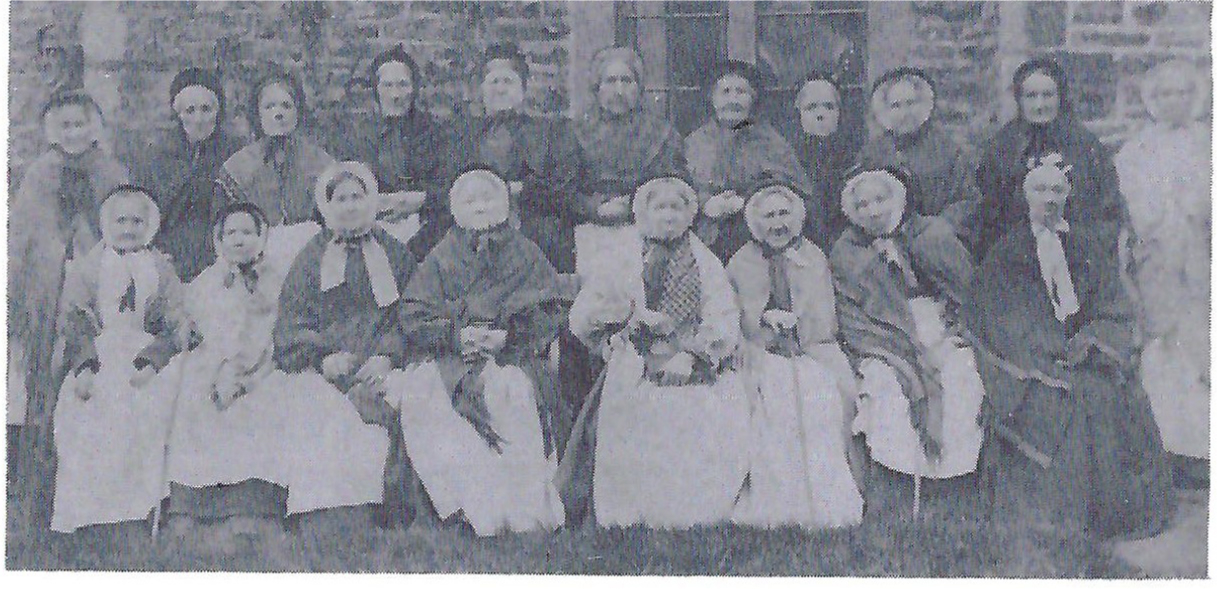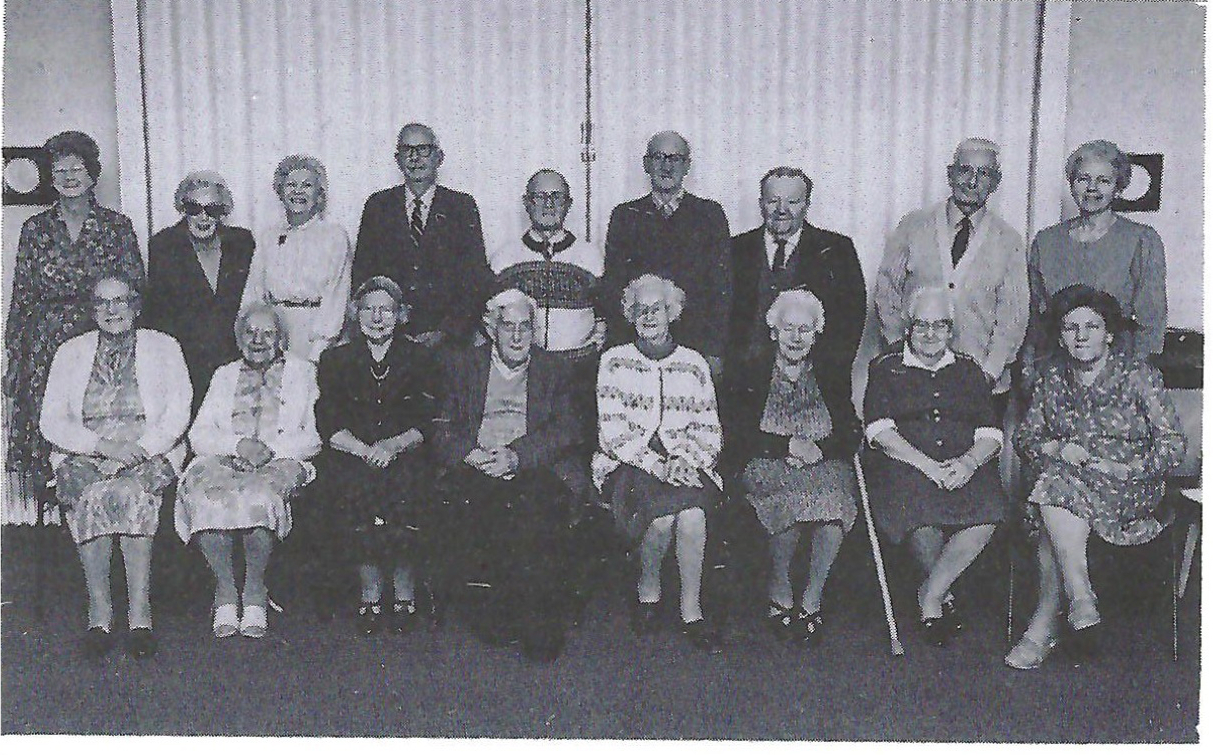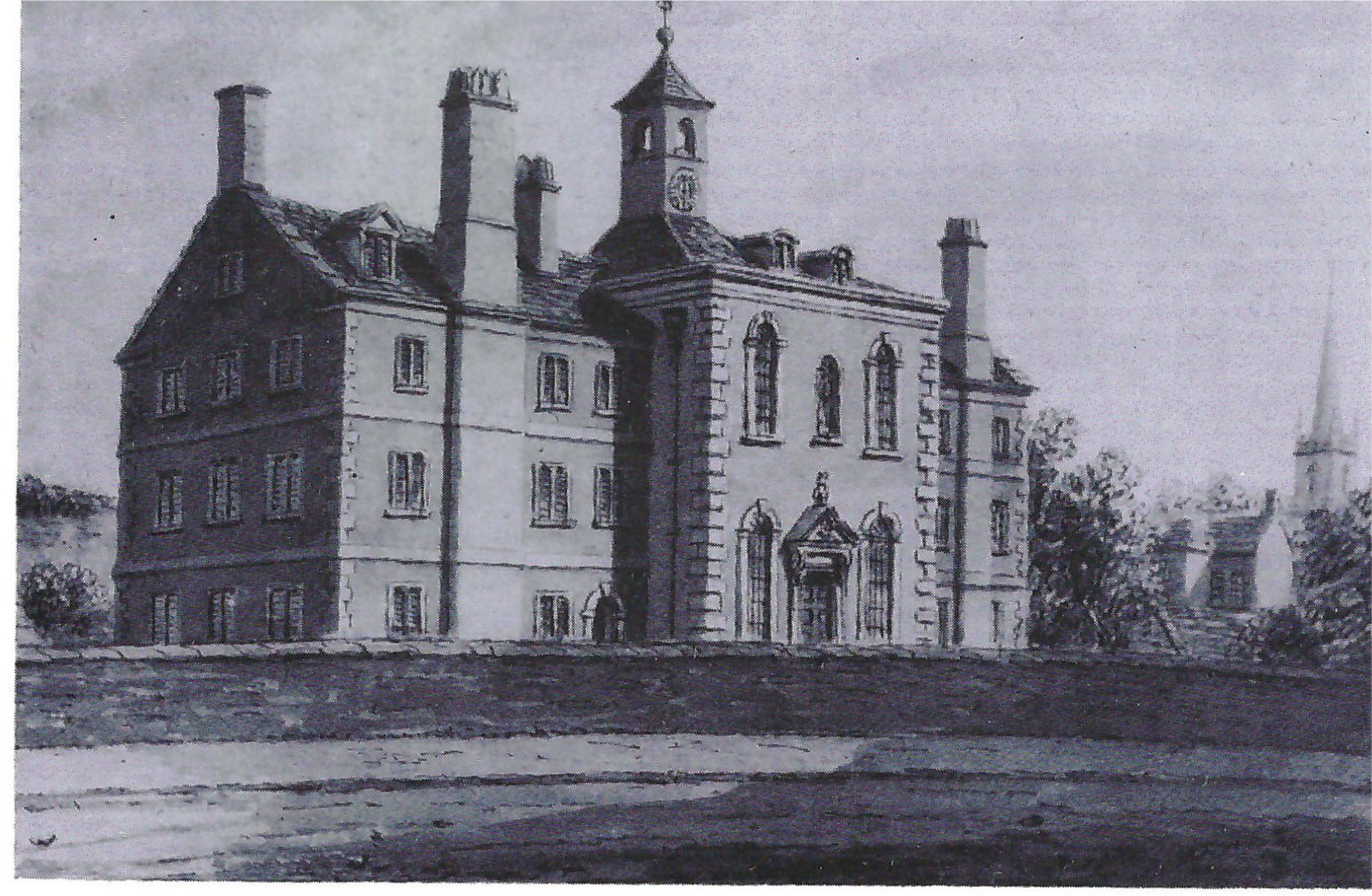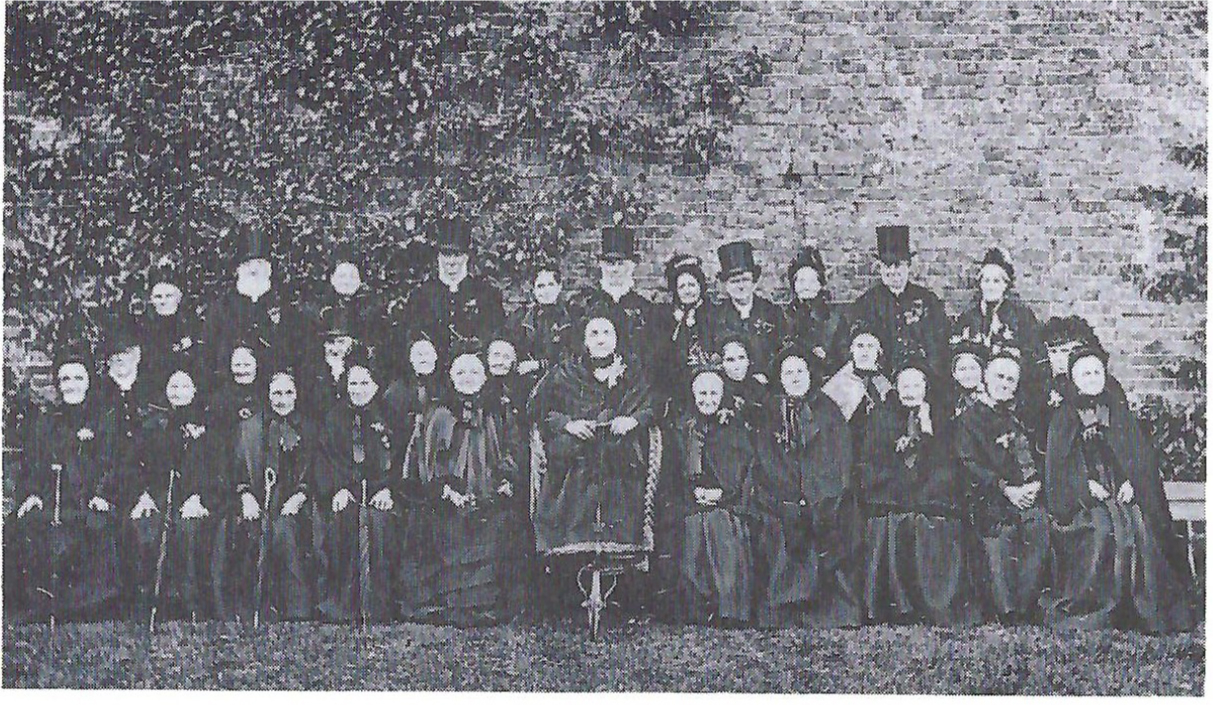A quaint name, The Blue House, like something out of a fairy story, curiously applied to this stately grey-stone building which rises above the market-place in the very centre of the town. We accept the name and the building without a second thought, taking both for granted like some familiar relative. The Blue House is dignified but friendly, a reassuring presence and, apparently, an immutable part of the Frome scene. Frome without the Blue House is unthinkable yet it has not survived purely of its own volition but due to the effort and generosity of Frome people. This has been forthcoming generation after generation and continues to this day.
It was more than 500 years ago that William Leversedge, the Lord of the Manor, was moved by the plight of the Frome homeless and decided to do something about it. Compassion was an unusual sentiment amongst members of this difficult and cantankerous family, but William seems to have been a gentle man. He may have been influenced by the experience of his brother Edmund, a vain and dissipated youth who received a sharp lesson when he was struck down by the plague in Frome in 1465. His face became ‘black as any coal’, his tongue ‘as black as any pitch’ and protruded out of his mouth ‘the length of half a foot’. Edmund fell into a death-like trance and while in this state was taken on a journey through Hell. He survived to reform and record his experiences which may well have inclined the whole family to good works.
A deed of 1621 describes the Almshouse as having been founded 160 years before. This would take us back to 1461, but as William did not succeed his father until 1465, this seems too early, but it is likely that he established it soon after his accession and at any rate before his death in 1485. William’s almshouse consisted of a hall, chapel and 12 chambers and was endowed (not over generously) with 4 ½ acres of land. Little is recorded of the early history of the almshouse but by the 16th century it was receiving benefactions from Frome people. As early as 1538 William Kyppinge, of Buckland, left six cows for the relief of the ‘poure people’ in the almshouse on condition that the profits were spent ‘in mete and drynke and not in reparations’, a bequest that suggests the buildings already needed repair. Again, in 1543, William Catcote left 4d. each ‘to every poor person of the Almshouse in Frome’.

The ladies of the Blue House pose in front of the building in 1874. There were 20 residents including the one looking out of the window.
More information can be gleaned from a conveyance of 1621 in which Edmund Leversedge and Robert his son (the Leversedges continued to provide trustees as late as 1710) refer to the ‘late erected almshouse’ indicating that the structure had been rebuilt fairly recently. The revenues from the four acre endowment were earmarked for the maintenance of ‘twelve poor people, men and women, born or to be born in the said Parish of Froome to dwell and be resident’ there. No men seem to have been provided for in the early days, probably because the charity was not rich enough to provide separate accommodation for them. In 1588, Richard Suddon, of Tuckmarsh, left ‘unto the Almeshowse of Frome Selwoode fifty shillings to be paide to the use and behovfe of the poore’.
The Almshouse already occupied its present site in 1652 when it is described as ‘scituate neere the greate Bridge in the Towne of Froome Sellwood’. There are no records of gifts of land up to this date on which it might have been rebuilt so it has probably always been where it stands today. In 1644, ‘all that messuage or house called the Almeshouse’ with gardens to the north and south was conveyed to new trustees together with land in the North Field of Frome, in Nunney and at Garston stile.
A major benefaction, which almost amounted to a re-foundation, took place in 1652 under the will of William Stafford. He was a wealthy London merchant who had been born in Frome and retained an affection for the town of his nativity. Stafford left an annuity of £30 a year to be paid out of the rents of property in Bread Street in the City of London ‘towards the perpetual! reliefe and sustanacon for ever of fowrteene poore woeman’ who were to live in the almshouse. In fact they were to get £2 each distributed in the form of a 3d. and a 6d. loaf once a week. The remaining £2 was to be spent on two sermons at St. John’s, a dinner for the vicar and trustees and a present of gloves for them, a particular mark of honour. There was no question of gloves for the almswomen, but in 1674, William Iveleaf gave half the rents of some property of his at Beckington to provide 14 poor women with gowns. These had to last three years.

The residents of the Blue House with the Warden and Deputy Warden photographed by John Frapwell in November, 1992. They are (from left to right) front row sitting: Mrs. Ruby Parsons, Mrs. Elsie Shipley, Mrs. Irene Wilson, Mr. George Cansdell, Mrs. Florence Dimmack, Mrs. Eva King, Mrs. Gwen White, Mrs. Renee Tudgay. Standing: Mrs. Doreen Marshall (Warden), Mrs. Beryl Smart, Mrs. Wyn Cash, Mr. Fred Woolley, Mr. Bert Harding, Mr. Maurice Whittington, Mr. Arthur Bennett, Mr. Fred Corp, Mrs. Valerie Tucker (Deputy Warden).
In 1686 there was a half-hearted attempt to bring relief to men who had fallen on hard times_. Richard Coomb left rents from fields near Whatley Water ‘for the use of a poor honest man, a native of Frome, living in the Almshouse, if any such can be found: if not to an honest poor woman’. Coomb, too, provided the trustees with gloves, a dinner and, as a bonus ‘a quart of wine-sack to be drank . . . on the next Monday after Michaelmas’.
None of the bequests was for the fabric and by the early 18th century the almshouse was again in decay. Its saviour was a public-spirited local solicitor,James Wickham, who came up with a daring plan for completely rebuilding the structure at the same time incorporating a charity school to cope with the educational needs of a growing population. Wickham came from an ancient family originally from Bristol, but later of Horsington, who claimed kinship with William of Wykeham, founder of Winchester College and used the famous motto manners maketh man. Wickham came to Frome as a young man about 1690 and married into the Whitchurch family becoming part of the local Establishment. It was as churchwarden of St. John’s that he launched his appeal for funds with such aplomb that dissenters as well as Anglicans were persuaded to give generously.
The new building, probably the third on the site and that which we see today, was erected between 1720 and 1728 at a cost of £1401.8s.9d. The design seems to be of the pattern book variety, the plan no doubt produced by Wickham or his chief contractor, a mason called Richard Coombes. Besides the main building, the price covered the re-construction of two arches ·of the town bridge, a guardhouse and various walls. Also included were payments of £12.8s.for the well-known figures of ‘Nancy Guy and Billy Ball up against the Blue School wall’ and £22 for the clock made by James Clark. The building swallowed 48,000 laths and 12,240 feet of oak board.
Much of the individuality and charm of the Blue House comes from the curious mixture of styles used in the structure, giving it what Sir Nikolaus Pevsner has called a disjointed appearance. The centre represents a fairly sophisticated essay in classical architecture. It is faced with ashlar and framed by quoins and has four large ‘Roman’ windows with keystones placed symmetrically.

The Blue House from a painting by John Buckler about 1845. On the right hand side can be seen the back view of the Iron Gates and the spire of St. John’s Church. Reproduced by kind permission of the Somerset Archaeological and Natural History Society.
The doorcase is imposing and has a fashionable pediment arid bolection moulding. A hipped roof with cupola and clock crowns the whole imposing edifice. It would not be out of place in Bath, Bristol or any other Georgian city and has been described by Bryan Little as ‘an admirable work of vernacular baroque’. This was intended for the school. In contrast are the plain recessed wings with their old-fashioned mullioned windows, the chimneys set centrally in their facades, which were reserved for the almswomen.
James Wickham died in 1727 and was succeeded in his practice by his nephew, also James. Later, a Wickham invited a Cruttwell from Bath to be a partner. Cruttwell in turn went into partnership with his nephew, George Alfred Daniel, also from Bath, forming the well-known Frome firm of Daniel & Cruttwell.
So the new almshouse rose from the ashes of the old, known now as the Blue School, or the Blue House from the knee-length blue coats with brass buttons worn by the school boys. They were also supplied with tam o’shanter caps with red bands and tassels. These boys can be seen decorating the foreground of many old photographs of Frome taken before 1914. The school was entered through the main central door while on each side were separate entrances to the south wing, occupied by 14 women supported by the Leversedge and Stafford bequests, and the north wing, home to 17 pauper women maintained by later legacies given by the Sheppard, Lacy and Bailey families. The women shared furnished rooms and were given a small allowance. The income of the trustees was increased through the year by the. gifts of Frome people until, in 1833, it totalled £205.8s. a year at a time when wages were a few shillings a week.
The charming statues of two serving girls which stand outside the Blue House came from Keyford ‘Home’, founded by Richard Stevens, a wealthy leather currier, in 1796 as an almshouse for old men and as a school for training girls for service. Stevens Asylum and Hospital, as it was officially known, was completed in 1803 at a cost of £6439. 18s. and, sadly, demolished in 1956. Frome judiciously separated the boys from the girls and the old men from the old women. John Stevens, Richard’s brother, further endowed the Blue School, adding 10 boys to the establishment. They wore white tassels to distinguish them from the foundation scholars. Richard also left instructions in his will that a silver pen should be given to the best mathematician and the scholar with the best handwriting on alternate years. The Blue School closed in 1921, the pupils being transferred to the new grammar school at Northcote House, now Frome Community College.
Deprived of the school, the Blue House fell on evil days. In 1866, it was ‘much in want of repair’ and restored by the trustees.
According to Kelly’s Directory of Somerset there were 25 residents in 1894 ‘each of whom has a weekly allowance of 5s. or 5s.6d. and a furnished room; there are also two nurses who receive a weekly salary’. The endowments were then valued at £8,802 which produced £446.12s. a year. Although the building remained broadly sound, it needed a thorough overhaul. Those who knew it after the Second World War, remember it as grim and bleak. It was four storeys high, subject to flooding and inadequately heated, hardly up to modern standards for the care of the elderly. In the early 1960s the threat of demolition loomed large with the prospect of the residents being whisked off from ‘a centre of life’ to ‘some arid estate far away’. These were the days before we all became conservationists when much of old Frome bit the dust in common with a good deal of our architectural heritage nationally.

Part of the Blue House was ·used as a school from 1728 until 1921. J. Munro, of Dungarvan Buildings, photographed this smart group of senior lads about 1870
Frome, however, had always had a soft spot for the Blue House and, once again, there was a rally of public opinion in its favour. A successful appeal was launched for £4,000, a sufficient sum in those days to restore and refit the building according to an imaginative scheme drawn up by D.A.S. Webster, of the Wyvern Design Group in Devizes. The Blue House was brought up to date, central heating and a lift installed and 18 flatlets created plus two extra ones for a matron and assistant. The Blue House became a much more cheerful and comfortable place. The familiar lockers in the hall and the Churchill Room were part of this refurbishment. The work is described and recorded in The Blue House Restored, published in 1965. It has contributions from Peter Belham, Eunice Overend and Lady Violet Powell and is now rare. In a preface John Betjeman refers to the restoration as a triumph and compliments Frome on preserving ‘one of its chief Georgian ornaments which will also remain as a tribute to its foresight and its heart’. Betjeman was not only pleased that a fine building had been saved but also realized the value of the residents being so ‘companionably placed’.

A more formal group of Blue ladies-one enthroned in a wheel chair-in their official gowns and cloaks taken about 1880. The top–hatted gentlemen may be the trustees of the day.
The Blue House is now a completely independent Foundation, and receives no financial subsidy or grant from any public source. It runs entirely on the income from its ancient endowments, the modest ‘fair rents’ it is allowed to charge to its residents, and the proceeds of special events such as its Open Garden events and coffee mornings. While these funds are sufficient, with careful management, for the everyday expenses of lighting, heating, maintenance and salaries, the trustees have to look for assistance for any major capital improvement projects.
Should you wish to discuss the possibility of an endowment, gift or donation to the Blue House, please contact the manager at:
The Blue House, The Bridge, Frome, BA11 1AP, Tel: (01373) 462577
E-mail: manager@thebluehousefrome.co.uk